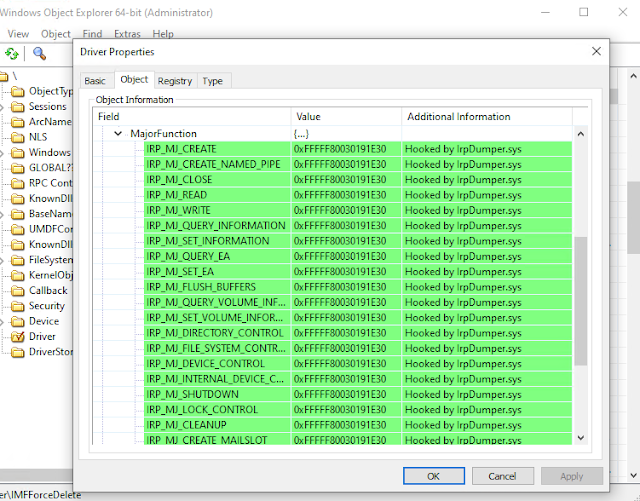Canadian Furious Beaver - A Tool For Monitoring IRP Handler In Windows Drivers, And Facilitating The Process Of Analyzing, Replaying And Fuzzing Windows Drivers For Vulnerabilities
Furious Beaver is a distributed tool for capturing IRPs sent to any Windows driver. It operates in 2 parts:
-
the "Broker" combines both a user-land agent and a self-extractable driver (
IrpDumper.sys) that will install itself on the targeted system. Once running it will expose (depending on the compilation options) a remote named pipe (reachable from\\target.ip.address\pipe\cfb), or a TCP port listening on TCP/1337. The communication protocol was made to be simple by design (i.e. not secure) allowing any 3rd party tool to dump the driver IRPs from the same Broker easily (via simple JSON messages). -
the GUI is a Windows 10 UWP app made in a
ProcMon-style: it will connect to wherever the broker is, and provide a convienent GUI for manipulating the broker (driver enumeration, hooking and IRP capturing). It also offers facililties for forging/replaying IRPs, auto-fuzzing (i.e. apply specific fuzzing policies on each IRP captured), or extract IRP in various formats (raw, as a Python script, as a PowerShell script) for further analysis. The captured data can be saved on disk in an easily parsable format (*.cfb= SQLite) for further analysis, and/or reload afterwards in the GUI.
Although the GUI obviously requires a Windows 10 environment (UWP App), the Broker itself can be deployed on any Windows 7+ host (x86 or x64).
The target host must have testsigning BCD policy enabled, as the self-extracting driver is not WHQL friendly.
Screenshots
Intercepted IRP view
IrpDumper.sys is the driver part of the CFB Broker that will auto-extract and install when launched. The driver will be responsible for hooking the IRP Major Function table of
the driver that is requested to be hooked, via an IOCTL passed from the Broker.
Upon success, the IRP table of the driver will then be pointing to IrpDumper.sys interception routine, as we can easily see with a debugger or tools like WinObjEx64.
IrpDumper.sys in itself then acts a rootkit, proxy-ing all calls to the targeted driver(s). When a DeviceIoControl is sent to a hooked driver, IrpDumper will simply capture the data if any, and push a message to the user-land agent (Broker), and yield the execution back to the legitimate drivers, allowing the intended code to continue as expected.
The Broker stores all this data in user-land waiting for a event to ask for them.
Build
GUI
Clone the repository, and build the Broker in the solution CFB.sln at the project root with Visual Studio (Debug - very verbose - or Release). Additionally, you can build the App GUI by building the GUI (Universal Windows) project.
Command line
Clone the repository and in a VS prompt run
C:\cfb\> msbuild CFB.sln /p:Configuration=$Conf
Where $Conf can be set to Release to Debug.
Setup
A Windows 7+ machine (Windows 10 SDK VM is recommended)
On this target machine, simply enable BCD test signing flag (in cmd.exe as Admin):
C:\> bcdedit.exe /set {whatever-profile} testsigning on
If using in Debug mode, IrpDumper.sys will provide a lot more valuable information as to what's being hooked (the price of performance).
All those info can be visible via tools like DebugView.exe or a kernel debugger like WinDbg. In either case, you must enable kernel debug
BCD flag (in cmd.exe as Admin):
C:\> bcdedit.exe /set {whatever-profile} debug on
It is also recommended to edit the KD verbosity level, via:
- the registry for a permanent effect (
reg add "HKLM\SYSTEM\CurrentControlSet\Control\Session Manager\Debug Print Filter" /v DEFAULT /t REG_DWORD /d 0xf) - directly from WinDbg for only the current session (
ed nt!Kd_Default_Mask 0xf)
If you plan on (re-)compiling any of the tools, you must install VS (2019 preferred). If using the Release binaries, you only need VS C++ Redist installed (x86 or x64 depending on your VM architecture).
Follow the indications in the Docs/ folder to improve your setup.
Command-line client
Several command line tools (such as dumping all data to SQLite database, fuzzing IRP, etc.) can be found in the external repository CFB-cli.
Why the name?
Because I had no idea for the name of this tool, so it was graciously generated by a script of mine.
 Reviewed by Zion3R
on
5:30 PM
Rating:
Reviewed by Zion3R
on
5:30 PM
Rating:














